Reviewing the Role of Key Performance Indicators in Architectural and Urban Design Practices
Abstract
1. Introduction
Aim of the Study
- Identify the main research fields related to building and urban design that consider KPIs.
- Among the fields identified in Point 1, define and discuss the main purposes related to the use of KPIs.
- Identify the most common methodologies used for KPIs evaluation in building and urban design.
- Evaluate if and how KPIs are considered in terms of sustainability evaluation and the main aspect of sustainability considered in the literature.
2. Materials and Methods
- Which KPIs were considered.
- If the research was based on simulations or field measurements, or even in the case of a literature review.
- Scale considered (urban, building, building element, the component of building element).
- Aim of the use of KPIs.
- The aim of the research and the relative role of KPIs.
- The specific field (urban, building, building materials, building component, a component of building component).
- The tools, e.g., simulations or field measurements.
3. Results and Discussion
- Manufacturing;
- Building design;
- Engineering and technology of building/infrastructure/materials (so, mainly related also to building construction and urban design);
- Urban design. (Figure 2):
- Indoor comfort KPIs: e.g., indoor thermal comfort/thermal comfort score, indoor air quality, daylight factor.
- Energy-related KPIs: e.g., energy consumption/demand, daily energy use, renewable energy sources.
- Economic KPIs: e.g., initial costs, investment costs, cost in use.
- Social KPIs: e.g., degree of satisfaction, degree of privacy, accessibility.
- Environmental KPIs: e.g., carbon absorption by trees, radiation: sum of shortwave radiation coming into project area; albedo: average albedo of the project area.
- Architectural (compositional) KPIs: e.g., layout, floor area, architectural form.
- Building technical KPIs: e.g., average thermal transmittance, ventilation heat losses, solar heat gains.
- Other KPIs: e.g., security, location, changes to legislation.
- Energy-related;
- Indoor comfort;
- Building technical;
- Environmental;
- Economical;
- Others (very case-specific KPIs mainly related to performances of single components);
- Social—architectural (compositional aspects).
4. Conclusions
- The review highlights the adaptability of KPIs as tools for managing complexity and measuring specific performances. The main research that considers KPIs as a tool to measure building and urban design performance are engineering and technology, while in the field of architectural and urban design these are used much more rarely (243 articles for engineering and technology, 76 articles for architectural and urban design).
- KPIs are widely used to evaluate the performances of products or elements, sometimes within their life span; therefore, KPIs are used to evaluate performances at different scales, starting from the element scale, up to the urban scale. In particular, the main aim of using KPIs in reviewed papers is to optimize performance (17 papers) or to improve sustainability (36 papers).
- The most common methodology used to validate a research hypothesis is software simulations, while field measurements are rarely used (41 simulations/8 field measurement). Sometimes, these two methodological approaches are used combined in order to validate the results.
- Of the selected articles, 36/76 focus on the role of KPIs for the sustainability improvement of buildings or one of its components (e.g., materials, production process of technical components of a building). Among the 36 sustainability-related articles, 8 are directly related to energy use reduction.
- An in-depth study of the papers related to architectural and urban planning fields show that the focus of the research is mainly placed at the building scale (50/76 articles). KPIs are demonstrated to be a promising tool to manage the increasing complexity of the building construction sector at a time of great change due to climate change issues, which require a greater control over the construction process and the life cycle of buildings and cities, in order to afford satisfactory standards of sustainability.
- Overall, the review of the papers shows that KPIs can be an effective tool for architectural design although they are not fully exploited in this field compared to other related areas of study such as engineering. This study also highlighted the importance of using KPIs to manage and assess the impacts of architectural and urban interventions.
- In parallel, the identification of parameters used for evaluation can be a first step to deepen the methods used to assess performance and, if needed, to propose new and more accurate approaches. Further research should consider methodological approaches and tools used in order to improve the efficiency of the evaluation in relation to specific goals (starting from SDGs for sustainable development). In parallel, results from the review could be validated through the application on a real case study.
- In addition, future research could be oriented toward the definition of composite indicators to propose a more accurate assessment of the environmental sustainability of a project not only in terms of reducing design impacts but also in terms of adaptation to and mitigation of climate change.
Supplementary Materials
Author Contributions
Funding
Conflicts of Interest
References
- Buildings–Topics. Available online: https://www.iea.org/topics/buildings (accessed on 14 October 2022).
- Sadatshojaie, A.; Rahimpour, M.R. CO2 Emission and Air Pollution (Volatile Organic Compounds, Etc.)—Related Problems Causing Climate Change. In Current Trends and Future Developments on (Bio-) Membranes; Elsevier: Amsterdam, The Netherlands, 2020; pp. 1–30. ISBN 978-0-12-816778-6. [Google Scholar]
- Andrić, I.; Al-Ghamdi, S.G. The Impact of Climate Change on Urban Environment in GCC Countries and Related Energy Systems: Mitigation Measures and Associated Challenges. In Proceedings of the International Conference on Sustainable Infrastructure 2019; American Society of Civil Engineers: Los Angeles, CA, USA, 2019; pp. 100–109. [Google Scholar]
- Rosenzweig, C.; Urban Climate Change Research Network (Eds.) Climate Change and Cities: Second Assessment Report of the Urban Climate Change Research Network; Cambridge University Press: New York, NY, USA, 2018; ISBN 978-1316603338. [Google Scholar]
- Masson, V.; Lemonsu, A.; Hidalgo, J.; Voogt, J. Urban Climates and Climate Change. Annu. Rev. Environ. Resour. 2020, 45, 411–444. [Google Scholar] [CrossRef]
- Revi, A.; Satterthwaite, D.E.; Aragón-Durand, F.; Corfee-Morlot, J.; Kiunsi, R.B.R.; Pelling, M.; Roberts, D.C.; Solecki, W. Urban Areas. In Climate Change 2014: Impacts, Adaptation, and Vulnerability. Part A: Global and Sectoral Aspects; Contribution of Working Group II to the Fifth Assessment Report of the Intergovernmental Panel on Climate Change; Cambridge University Press: Cambridge, UK, 2014. [Google Scholar]
- Nyka, L. Bridging the Gap between Architectural and Environmental Engineering Education in the Context of Climate Change. World Trans. Eng. Technol. Educ. 2019, 17, 204–209. [Google Scholar]
- Allouhi, A.; El Fouih, Y.; Kousksou, T.; Jamil, A.; Zeraouli, Y.; Mourad, Y. Energy consumption and efficiency in buildings: Current status and future trends. J. Clean. Prod. 2015, 109, 118–130. [Google Scholar] [CrossRef]
- Harish, V.; Kumar, A. A review on modeling and simulation of building energy systems. Renew. Sustain. Energy Rev. 2016, 56, 1272–1292. [Google Scholar] [CrossRef]
- Al Dakheel, J.; Del Pero, C.; Aste, N.; Leonforte, F. Smart buildings features and key performance indicators: A review. Sustain. Cities Soc. 2020, 61, 102328. [Google Scholar] [CrossRef]
- Chan, A.P.C.; Chan, D.W.M.; Chiang, Y.H.; Tang, B.S.; Chan, E.H.W.; Ho, K.S.K. Exploring Critical Success Factors for Partnering in Construction Projects. J. Constr. Eng. Manag. 2004, 130, 188–198. [Google Scholar] [CrossRef]
- Kylili, A.; Fokaides, P.A.; Jimenez, P.A.L. Key Performance Indicators (KPIs) approach in buildings renovation for the sustainability of the built environment: A review. Renew. Sustain. Energy Rev. 2016, 56, 906–915. [Google Scholar] [CrossRef]
- United Nations. Our Common Future Report of the World Commission on Environment and Development; United Nations: New York, NY, USA, 1987. [Google Scholar]
- Purvis, B.; Mao, Y.; Robinson, D. Three pillars of sustainability: In search of conceptual origins. Sustain. Sci. 2018, 14, 681–695. [Google Scholar] [CrossRef]
- Allen, T.F.H.; Hoekstra, T.W. Toward a Definition of Sustainability. In Sustainable Ecological Systems: Implementing an Ecological Approach to Land Management; Rocky Mountain Forest and Range Experiment Station: Fort Collins, CO, USA, 1993; pp. 98–107. [Google Scholar]
- United Nations. Transforming Our World: The 2030 Agenda for Sustainable Development; United Nations: New York, NY, USA, 2015. [Google Scholar]
- Ceschin, F.; Gaziulusoy, I. Evolution of design for sustainability: From product design to design for system innovations and transitions. Des. Stud. 2016, 47, 118–163. [Google Scholar] [CrossRef]
- Bhamra, T.; Lofthouse, V. Design for Sustainability; Routledge: London, UK, 2016; ISBN 978-1-317-15235-4. [Google Scholar]
- Burnham, J.F. Scopus database: A review. Biomed. Digit. Libr. 2006, 3, 1. [Google Scholar] [CrossRef]
- Ahmad, A.M.; Trejo, S.R.; Hafeez, M.A.; Dawood, N.; Kassem, M.; Naji, K.K. Drivers for energy analysis towards a BIM-enabled information flow. Smart Sustain. Built Environ. 2022. ahead-of-print. [Google Scholar] [CrossRef]
- Correia, D.; Marques, J.L.; Teixeira, L. City@Path: A Collaborative Smart City Planning and Assessment Tool. Int. J. Transp. Dev. Integr. 2021, 6, 66–80. [Google Scholar] [CrossRef]
- Kamari, A.; Schultz, C.P.L. A combined principal component analysis and clustering approach for exploring enormous renovation design spaces. J. Build. Eng. 2022, 48, 103971. [Google Scholar] [CrossRef]
- Marotta, I.; Guarino, F.; Cellura, M.; Longo, S. Investigation of design strategies and quantification of energy flexibility in buildings: A case-study in southern Italy. J. Build. Eng. 2021, 41, 102392. [Google Scholar] [CrossRef]
- Mihaela, C.; Mircea, C. A novel concept for designing the energy efficiency program. In Proceedings of the 2021 9th International Conference on Modern Power Systems (MPS), Cluj-Napoca, Romania, 16–17 June 2021; pp. 1–8. [Google Scholar] [CrossRef]
- D’Agostino, D.; D’Agostino, P.; Minelli, F.; Minichiello, F. Proposal of a new automated workflow for the computational performance-driven design optimization of building energy need and construction cost. Energy Build. 2021, 239, 110857. [Google Scholar] [CrossRef]
- Fratean, A.; Dobra, P. Key performance indicators for the evaluation of building indoor air temperature control in a context of demand side management: An extensive analysis for Romania. Sustain. Cities Soc. 2021, 68, 102805. [Google Scholar] [CrossRef]
- Doellken, M.; Lorin, A.; Thomas, N.; Sven, M. Identifying an opportunistic method in design for manufacturing: An experimental study on successful a on the manufacturability and manufacturing effort of design concepts. Procedia CIRP 2021, 100, 720–725. [Google Scholar] [CrossRef]
- Qian, M.; Yan, D.; Hong, T.; Liu, H. Operation and performance of VRF systems: Mining a large-scale dataset. Energy Build. 2020, 230, 110519. [Google Scholar] [CrossRef]
- Formentin, S.M. Key Performance Indicators for the Upgrade of Existing Coastal Defense Structures. J. Mar. Sci. Eng. 2021, 9, 994. [Google Scholar] [CrossRef]
- Chiesa, G.; Zajch, A. Contrasting Climate-Based Approaches and Building Simulations for the Investigation of Earth-to-Air Heat Exchanger (EAHE) Cooling Sensitivity to Building Dimensions and Future Climate Scenari-os in North America. Energy Build. 2020, 227, 110410. [Google Scholar] [CrossRef]
- Yoon, N.; Norford, L.; Malkawi, A.; Samuelson, H.; Piette, M.A. Dynamic metrics of natural ventilation cooling effectiveness for interactive modeling. Build. Environ. 2020, 180, 106994. [Google Scholar] [CrossRef]
- De Jaeger, I.; Reynders, G.; Callebaut, C.; Saelens, D. A building clustering approach for urban energy simulations. Energy Build. 2019, 208, 109671. [Google Scholar] [CrossRef]
- Jenkins, K.J.; Rudman, C.E.; Bierman, C.R. Delivering Sustainable Solutions through Improved Mix and Structural Design Functions for Bitumen Stabilised Materials. Adv. Mater. Sci. Eng. 2020, 2020, 7460174. [Google Scholar] [CrossRef]
- Huang, P.; Lovati, M.; Zhang, X.; Bales, C.; Hallbeck, S.; Becker, A.; Bergqvist, H.; Hedberg, J.; Maturi, L. Transforming a residential building cluster into electricity prosumers in Sweden: Optimal design of a coupled PV-heat pump-thermal storage-electric vehicle system. Appl. Energy 2019, 255, 113864. [Google Scholar] [CrossRef]
- Kusrini, E.; Ahmad, A.; Murniati, W. Design Key Performance Indicator for Sustainable Warehouse: A Case Study in a Leather Manufacturer. IOP Conf. Ser. Mater. Sci. Eng. 2019, 598, 012042. [Google Scholar] [CrossRef]
- Scharf, B.; Kraus, F. Green Roofs and Greenpass. Buildings 2019, 9, 205. [Google Scholar] [CrossRef]
- Kamari, A.; Schultz, C.P.L.; Kirkegaard, P.H. Constraint-based renovation design support through the renovation domain model. Autom. Constr. 2019, 104, 265–280. [Google Scholar] [CrossRef]
- Singh, K.; Sultan, I. A computer-aided unit process sustainable modelling for manufacturing processes: Case for extrusion process. Prod. Manuf. Res. 2019, 7, 143–160. [Google Scholar] [CrossRef]
- Chiesa, G. EAHX—Earth-to-air heat exchanger: Simplified method and KPI for early building design phases. Build. Environ. 2018, 144, 142–158. [Google Scholar] [CrossRef]
- An, J.; Yan, D.; Hong, T. Clustering and statistical analyses of air-conditioning intensity and use patterns in residential buildings. Energy Build. 2018, 174, 214–227. [Google Scholar] [CrossRef]
- De Tommasi, L.; Ridouane, H.; Giannakis, G.; Katsigarakis, K.; Lilis, G.N.; Rovas, D. Model-Based Comparative Evaluation of Building and District Control-Oriented Energy Retrofit Scenarios. Buildings 2018, 8, 91. [Google Scholar] [CrossRef]
- Del Pero, C.; Aste, N.; Paksoy, H.O.; Haghighat, F.; Grillo, S.; Leonforte, F. Energy storage key performance indicators for building application. Sustain. Cities Soc. 2018, 40, 54–65. [Google Scholar] [CrossRef]
- Hernández, J.L.; Sanz, R.; Corredera, Á.; Palomar, R.; Lacave, I. A Fuzzy-Based Building Energy Management System for Energy Efficiency. Buildings 2018, 8, 14. [Google Scholar] [CrossRef]
- Chan, D.; Cameron, M.; Yoon, Y. Implementationof micro energy grid: A case study of a sustainable community in China. Energy Build. 2017, 139, 719–731. [Google Scholar] [CrossRef]
- Samuel, E.I.; Joseph-Akwara, E.; Richard, A. Assessment of energy utilization and leakages in buildings with building information model energy. Front. Arch. Res. 2017, 6, 29–41. [Google Scholar] [CrossRef]
- Won, J.; Lee, G. How to tell if a BIM project is successful: A goal-driven approach. Autom. Constr. 2016, 69, 34–43. [Google Scholar] [CrossRef]
- Hempel, S.; Benner, J.; Geiger, A.; Häfele, K.-H. Streamer Early Design Configurator—A Tool for Automatic Layout Generation. In Proceedings of the Central Europe towards Sustainable Building 2016 (CESB16), Prague, Czech Republic, 22–24 June 2016; pp. 757–764. [Google Scholar]
- Foteinopoulos, P.; Stavropoulos, P.; Papacharalampopoulos, A.; Chryssolouris, G. Unified Approach in Design and Manufacturing Optimization of Hybrid Metal-composites Parts. Procedia CIRP 2016, 55, 59–64. [Google Scholar] [CrossRef][Green Version]
- Tamainot-Telto, Z. Novel method using Dubinin-Astakhov theory in sorption reactor design for refrigeration and heat pump applications. Appl. Therm. Eng. 2016, 107, 1123–1129. [Google Scholar] [CrossRef]
- Bonino, D.; De Russis, L. Design recommendations for smart energy monitoring: A case study in Italy. Energy Build. 2015, 91, 1–9. [Google Scholar] [CrossRef][Green Version]
- Tronchin, L.; Manfren, M. Multi-scale Analysis and Optimization of Building Energy Performance—Lessons Learned from Case Studies. Procedia Eng. 2015, 118, 563–572. [Google Scholar] [CrossRef]
- Riexinger, G.; Holtewert, P.; Bruns, A.; Wahren, S.; Tran, K.; Bauernhansl, T. KPI-focused Simulation and Management System for Eco-Efficient Design of Energy-Intensive Production Systems. Procedia CIRP 2015, 29, 68–73. [Google Scholar] [CrossRef]
- Lourenço, P.; Pinheiro, M.D.; Heitor, T. From indicators to strategies: Key Performance Strategies for sustainable energy use in Portuguese school buildings. Energy Build. 2014, 85, 212–224. [Google Scholar] [CrossRef]
- Farmani, R.; Butler, D. Implications of Urban Form on Water Distribution Systems Performance. Water Resour. Manag. 2013, 28, 83–97. [Google Scholar] [CrossRef]
- Hanley, C.; Gilmour, D.; Pakrashi, V. Effects of Large Uncertainties in a Reliability Based Framework for Hu-manitarian Emergency Shelters. In Proceedings of the 11th International Conference on Structural Safety and Reliability, New York, NY, USA, 16–20 June 2013; pp. 4873–4880. [Google Scholar]
- Hopfe, C.J.; Augenbroe, G.L.; Hensen, J.L. Multi-criteria decision making under uncertainty in building performance assessment. Build. Environ. 2013, 69, 81–90. [Google Scholar] [CrossRef]
- Spiegelhalter, T.; Pala, N.; Kang, Y.; Zuh, Y. Transforming and Benchmarking a LEED Certified University Building into a Net-Zero-Energy Building in the Subtropics; Florida International University: Miami, FL, USA, 2012. [Google Scholar]
- Drew, C.; Rehill, D.; Fanning, K.; Smith, A. A Sustainable Solution for Urbanization in China; 2012; pp. 471–478. Available online: https://global.ctbuh.org/resources/papers/download/958-a-sustainable-solution-for-urbanization-in-china.pdf (accessed on 28 October 2022).
- Alwaer, H.; Clements-Croome, D. Key performance indicators (KPIs) and priority setting in using the multi-attribute approach for assessing sustainable intelligent buildings. Build. Environ. 2010, 45, 799–807. [Google Scholar] [CrossRef]
- Da Solano, R.S.; De Oliveira, R. Economic Analysis of Housing Design; 2007; pp. 553–559. Available online: https://centaur.reading.ac.uk/31329/1/CME25-Whole_Procs.pdf#page=577 (accessed on 28 October 2022).
- Liu, A.; Miller, W.; Chiou, J.; Zedan, S.; Yigitcanlar, T.; Ding, Y. Aged Care Energy Use and Peak Demand Change in the COVID-19 Year: Empirical Evidence from Australia. Buildings 2021, 11, 570. [Google Scholar] [CrossRef]
- Cooper, J.; Lee, A.; Jones, K. Sustainable built asset management performance indicators and attributes: A UK Social Housing Case Study Example. Int. J. Build. Pathol. Adapt. 2020, 38, 508–522. [Google Scholar] [CrossRef]
- Schaumann, D.; Pilosof, N.P.; Gath-Morad, M.; Kalay, Y.E. Simulating the impact of facility design on operations: A study in an internal medicine ward. Facilities 2020, 38, 501–522. [Google Scholar] [CrossRef]
- Zanen, P.; Lambert, T. Lifecycle Quality Control of New Locks in a Public Private Partnership setup. In Proceedings of the IABSE Symposium: Towards a Resilient Built Environment Risk and Asset Management, Guimarães, Portugal, 27–29 March 2019; pp. 994–998. [Google Scholar] [CrossRef]
- Attia, S.; Bilir, S.; Safy, T.; Struck, C.; Loonen, R.; Goia, F. Current Trends and Future Challenges in the Perfor-mance Assessment of Adaptive Façade Systems. Energy Build 2018, 179, 165–182. [Google Scholar] [CrossRef]
- Chandanachulaka, N.; Khan-Ngern, W. Design of Zero Energy Consumption System for Small DC Residential Home Based on Off-Grid PV System. Int. Rev. Electr. Eng. 2018, 13, 246. [Google Scholar] [CrossRef]
- Wijegunarathna, E.; Wedawatta, G.; Prasanna, L.; Ingirige, B. Long-term satisfaction of resettled communities: An assessment of physical performance of post-disaster housing. Procedia Eng. 2018, 212, 1147–1154. [Google Scholar] [CrossRef]
- Villarreal, K.L.; Pellicer, E.; Rodriguez, S.G. Performance indicators for developer and homebuilder Mexican companies: A Delphi study. Rev. Constr. J. Constr. 2017, 16, 133–144. [Google Scholar] [CrossRef]
- Lai, J.H.; Hou, H.; Chiu, B.W.; Edwards, D.; Yuen, P.; Sing, M.; Wong, P. Importance of hospital facilities management performance indicators: Building practitioners’ perspectives. J. Build. Eng. 2021, 45, 103428. [Google Scholar] [CrossRef]
- Kaur, M.; Hewage, K.; Sadiq, R. Integrated level of service index for buried water infrastructure: Selection and development of performance indicators. Sustain. Cities Soc. 2021, 68, 102799. [Google Scholar] [CrossRef]
- Boorsma, N.; Balkenende, R.; Bakker, C.; Tsui, T.; Peck, D. Incorporating design for remanufacturing in the early design stage: A design management perspective. J. Remanufacturing 2020, 11, 25–48. [Google Scholar] [CrossRef]
- Alrashed, S. Key performance indicators for Smart Campus and Microgrid. Sustain. Cities Soc. 2020, 60, 102264. [Google Scholar] [CrossRef]
- Ghazvini, K.; Zandieh, M.; Vafamehr, M. Exploring KPIS Utilization Effects on Decision Making for the Architectural Design Process in Industrial Buildings. Civ. Environ. Eng. 2020, 16, 198–209. [Google Scholar] [CrossRef]
- Utrilla, P.N.-C.; Górecki, J.; Maqueira, J.M. Simulation-Based Management of Construction Companies under the Circular Economy Concept—Case Study. Buildings 2020, 10, 94. [Google Scholar] [CrossRef]
- Lam, T.Y. Driving sustainable construction development through post-contract key performance indicators and drivers. Smart Sustain. Built Environ. 2020. [Google Scholar] [CrossRef]
- Bitamba, B.F.; An, S.H. Study on Factors Affecting the Performance of Construction Projects in the Democratic Republic of the Congo. S. Afr. J. Ind. Eng. 2020, 31, 12–25. [Google Scholar] [CrossRef]
- Salvado, F.; de Almeida, N.M.; Azevedo, V. Historical analysis of the economic life-cycle performance of public school buildings. Build. Res. Inf. 2019, 47, 813–832. [Google Scholar] [CrossRef]
- Praharaj, S.; Han, H. Building a typology of the 100 smart cities in India. Smart Sustain. Built Environ. 2019, 8, 400–414. [Google Scholar] [CrossRef]
- Salis, L.C.R.; Abadie, M.; Wargocki, P.; Rode, C. Towards the definition of indicators for assessment of indoor air quality and energy performance in low-energy residential buildings. Energy Build. 2017, 152, 492–502. [Google Scholar] [CrossRef]
- Sezer, A.A. Contractor use of productivity and sustainability indicators for building refurbishment. Built Environ. Proj. Asset Manag. 2015, 5, 141–153. [Google Scholar] [CrossRef]
- Budawara, N.; Alkass, S. Key Performance Indicators to Measure Design Performance in Construction; Concordia University: Montreal, QC, Canada, 2009; Volume 3, pp. 1364–1374. [Google Scholar]
- Lützkendorf, T.; Lorenz, D. Sustainable property investment: Valuing sustainable buildings through property performance assessment. Build. Res. Inf. 2005, 33, 212–234. [Google Scholar] [CrossRef]
- Kamari, A.; Jensen, S.R.; Petersen, S.; Kirkegaard, P.H. Sustainability key performance indica-tors’ (kpis) assessment and visualization aimed at architects in (early) renovation design processes. Nord. J. Archit. Res. 2021, 33, 41–80. [Google Scholar]
- Ismail, S.; Mohamad, R.; Said, J.M. Performance indicators for lifecycle process of public private partnership (PPP) projects in Malaysia. Built Environ. Proj. Asset Manag. 2021, 12, 704–718. [Google Scholar] [CrossRef]
- Enshassi, A.A.; El Shorafa, F. Key performance indicators for the maintenance of public hospitals buildings in the Gaza Strip. Facilities 2015, 33, 206–228. [Google Scholar] [CrossRef]
- Sibiya, M.; Aigbavboa, C.; Thwala, W. Construction Projects’ Key Performance Indicators: A Case of the South African Construction Industry. In Proceedings of the 2015 International Conference on Construction and Real Estate Management, Lulea, Sweden, 11–12 August 2015. [Google Scholar] [CrossRef]
- Tiwari, R.; Jones, J.R. Mapping the Integrated Early Design Process of the Largest Net-Zero Energy Office Building. AEI 2015 2015, 594–605. [Google Scholar] [CrossRef]
- Okolie, K.C. Building Performance Evaluation in Educational Institutions: A Case-Study of Universities in South East Nigeria; Nelson Mandela Metropolitan University: Port Elizabeth, South Africa, 2009; pp. 1598–1625. [Google Scholar]
- Kamari, A.; Kirkegaard, P.H.; Schultz, C.P.L. Paradis—A process integrating tool for rapid generation and evaluation of holistic renovation scenarios. J. Build. Eng. 2020, 34, 101944. [Google Scholar] [CrossRef]
- Rasca, S. Do International Urban Sustainability Monitoring Frameworks Respond to the Perceived Needs of Norwegian small and mediumsized cities?—Results of a Workshop. In Proceedings of the 2020 Forum on Integrated and Sustainable Transportation Systems (FISTS), Delft, The Netherlands, 3–5 November 2020; pp. 315–322. [Google Scholar] [CrossRef]
- Boulanger, S.O.M.; Marcatili, M. Site-Specific Circular Methodology for the Resilience of Existing Districts: The Green City Circle. TECHNE J. Technol. Archit. Environ. 2018, 15, 203–211. [Google Scholar] [CrossRef]
- Fantini, P.; Palasciano, C.; Taisch, M. Back to Intuition: Proposal for a Performance Indicators Framework to Facilitate Eco-factories Management and Benchmarking. Procedia CIRP 2015, 26, 1–6. [Google Scholar] [CrossRef]
- Ghaffarianhoseini, A.; Berardi, U.; AlWaer, H.; Chang, S.; Halawa, E.; Ghaffarianhoseini, A.; Clements-Croome, D. What is an intelligent building? Analysis of recent interpretations from an international perspective. Arch. Sci. Rev. 2015, 59, 338–357. [Google Scholar] [CrossRef]
- Nourbakhsh, M.; Mydin, S.H.; Zin, R.M.; Zolfagharian, S.; Irizarry, J.; Zahidi, M. Relative Importance of Key Performance Indicators of Construction Projects towards Buildability at Design Stage. Adv. Mater. Res. 2012, 446–449, 340–344. [Google Scholar] [CrossRef]
- Lam, E.W.; Chan, A.P.; Chan, D.W. Benchmarking success of building maintenance projects. Facilities 2010, 28, 290–305. [Google Scholar] [CrossRef]
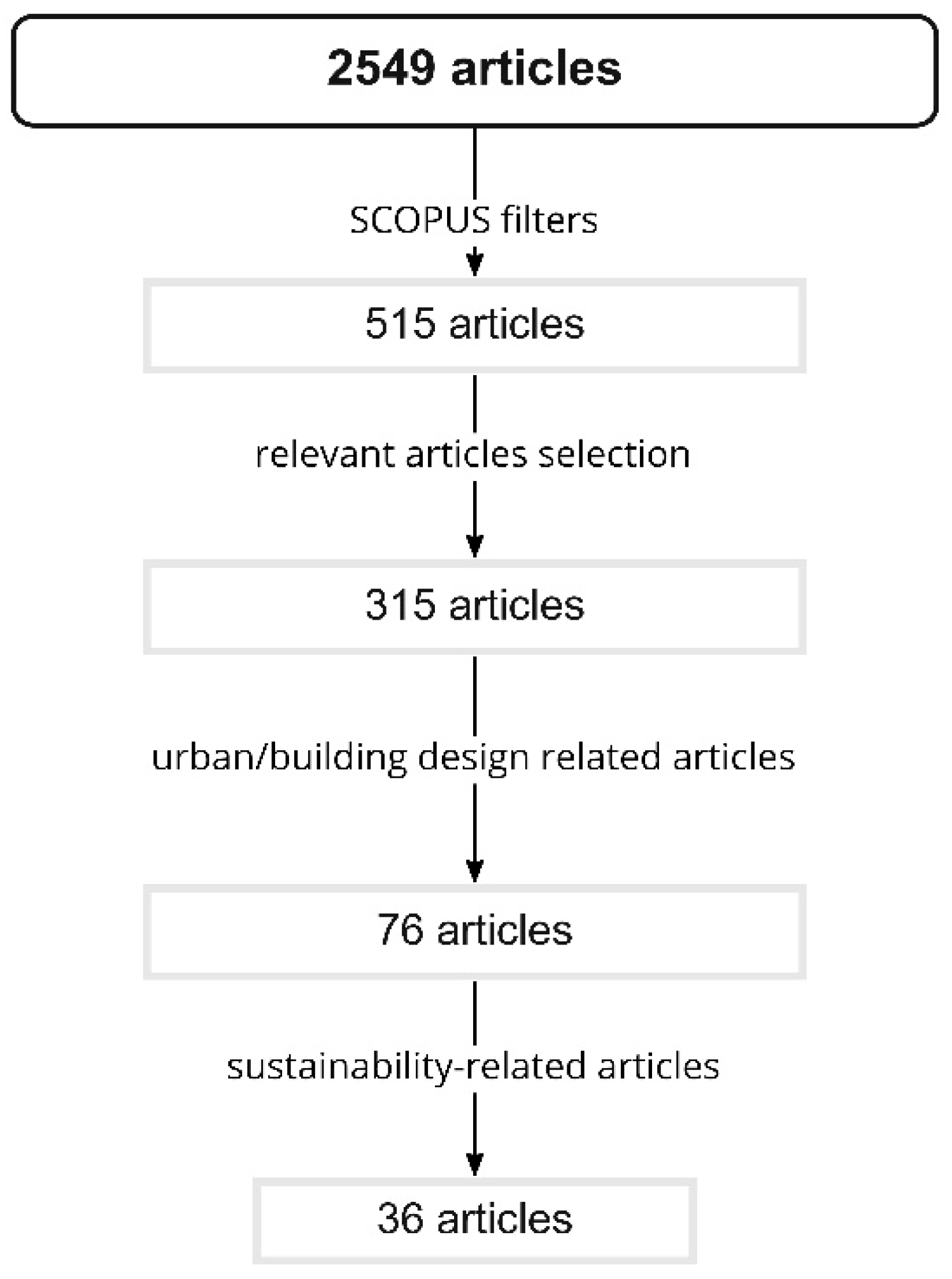
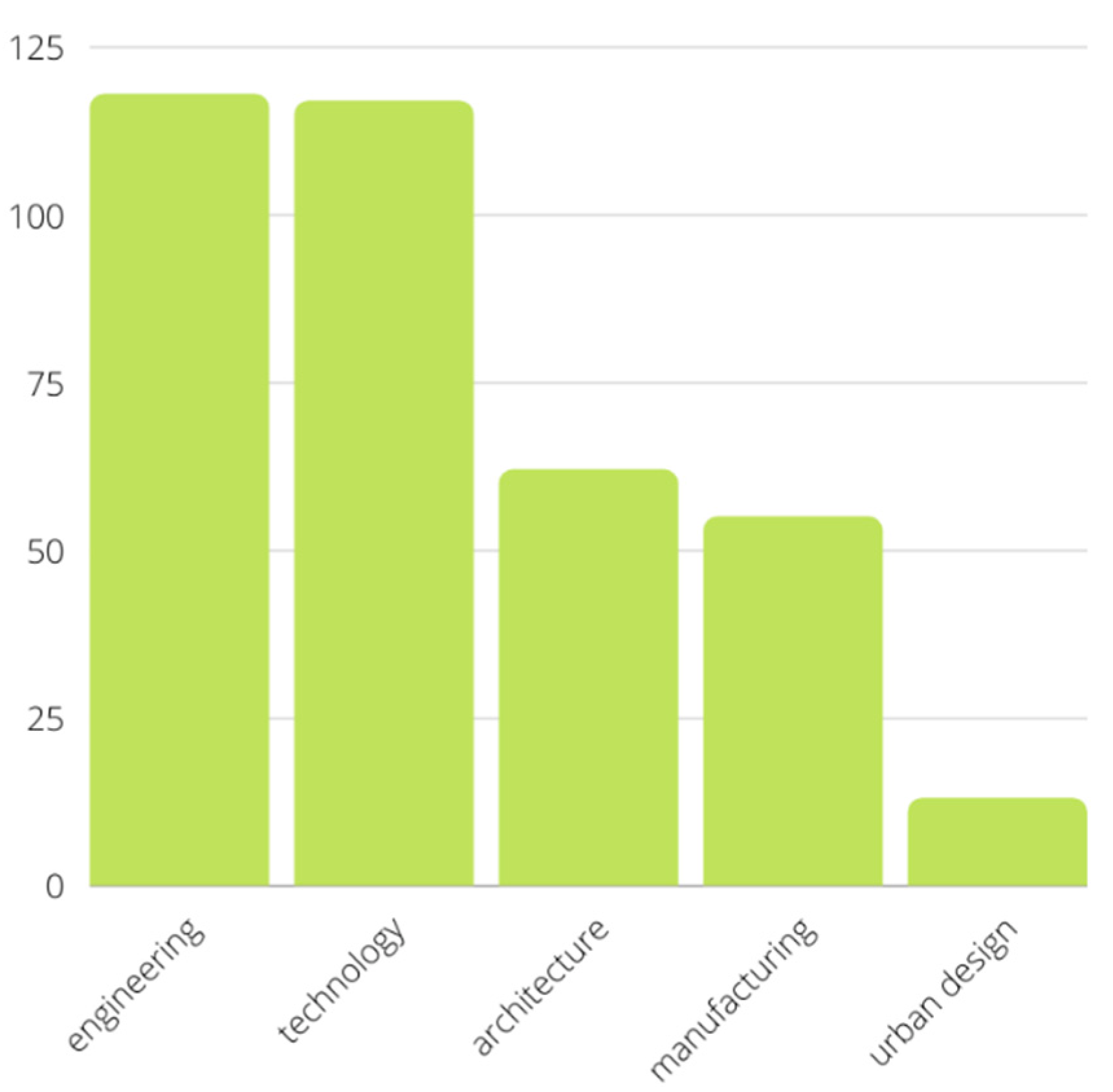

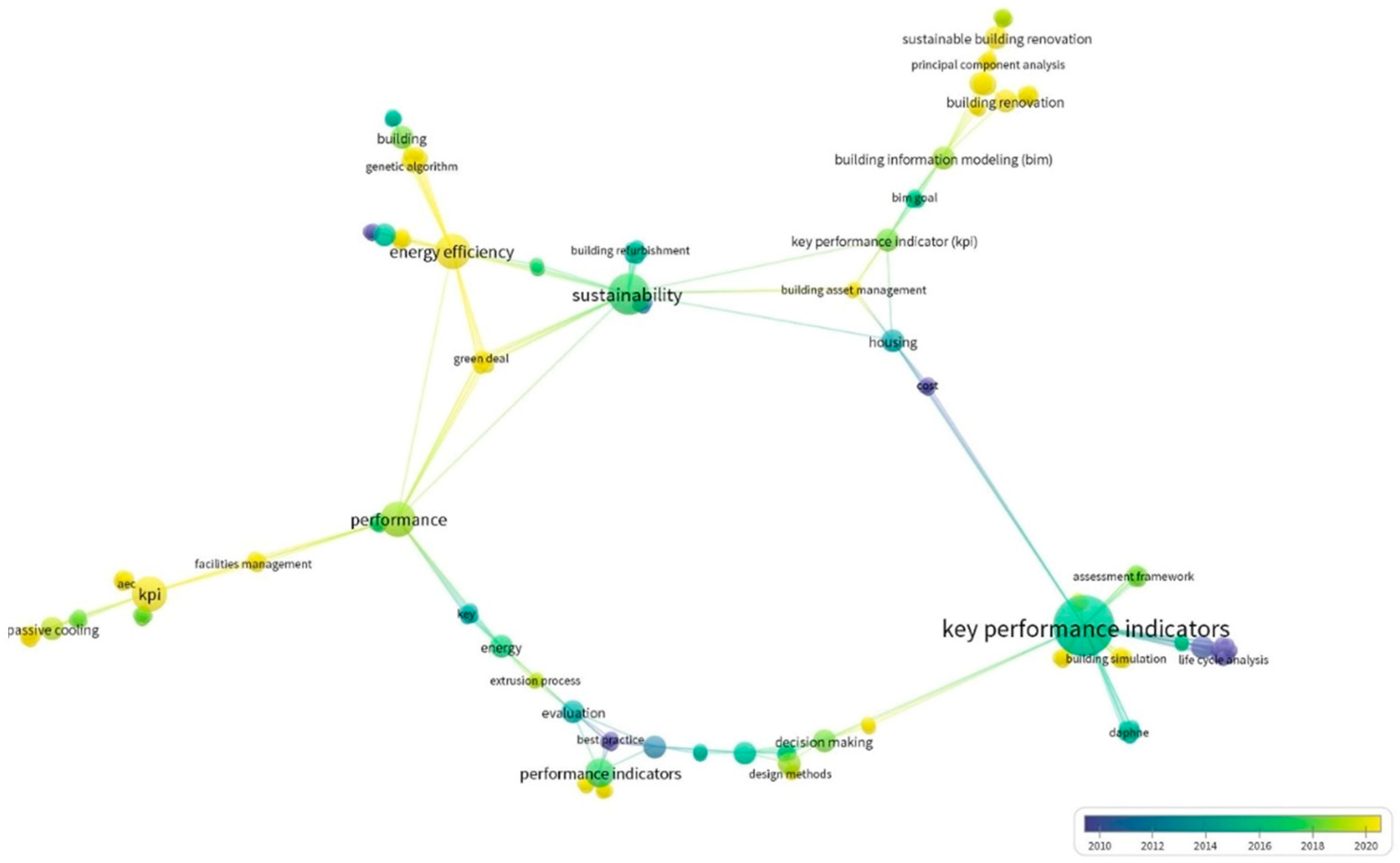
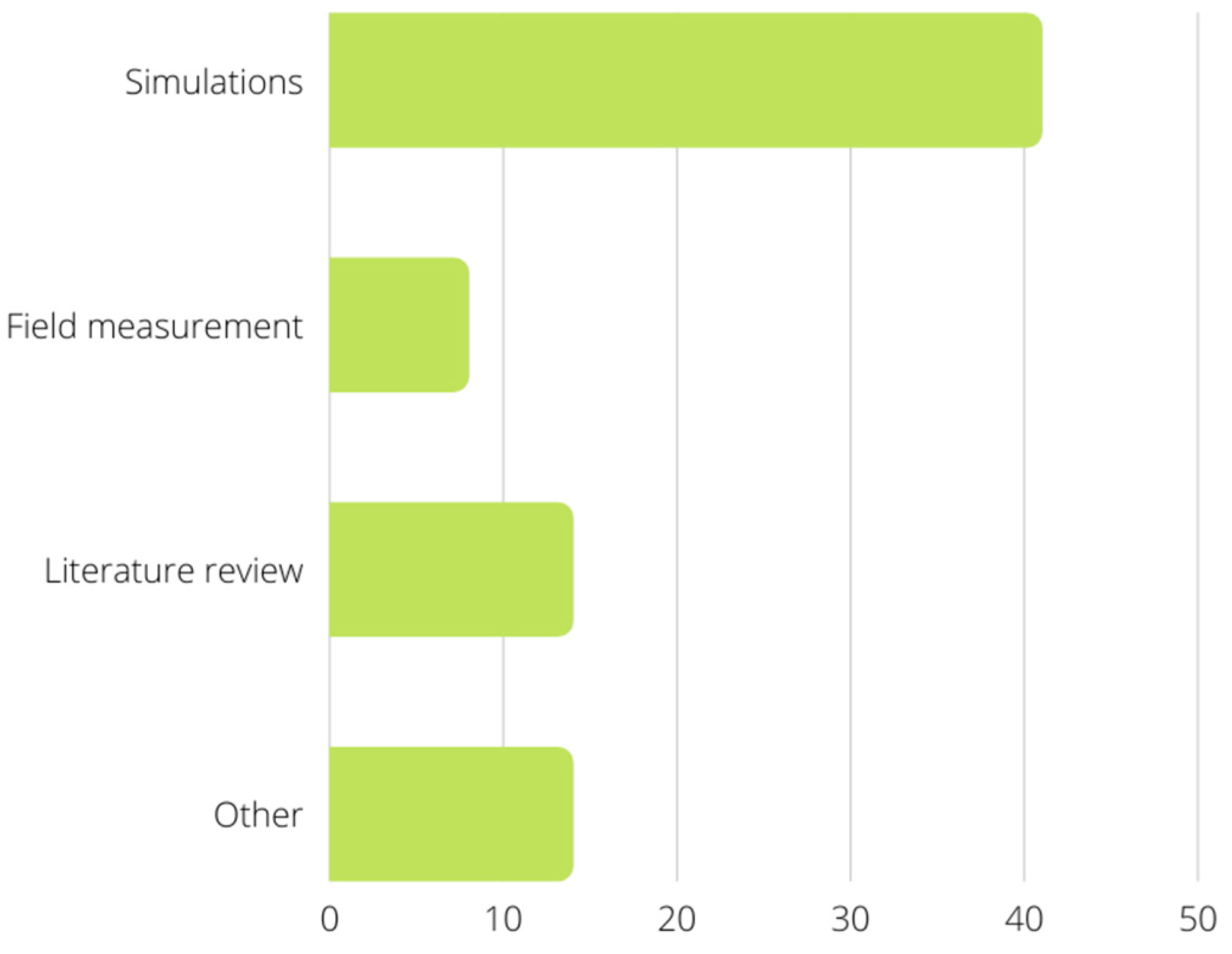
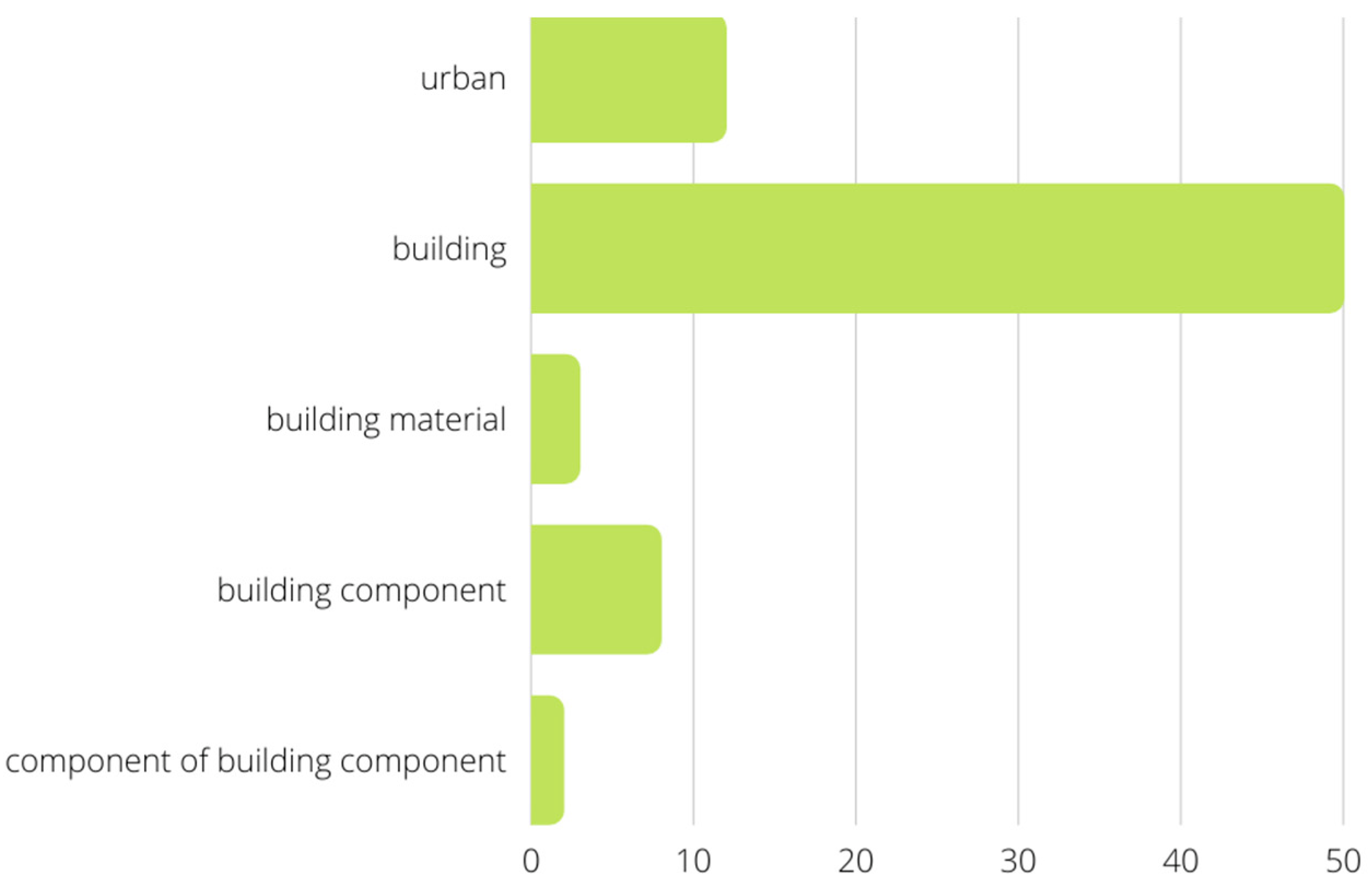
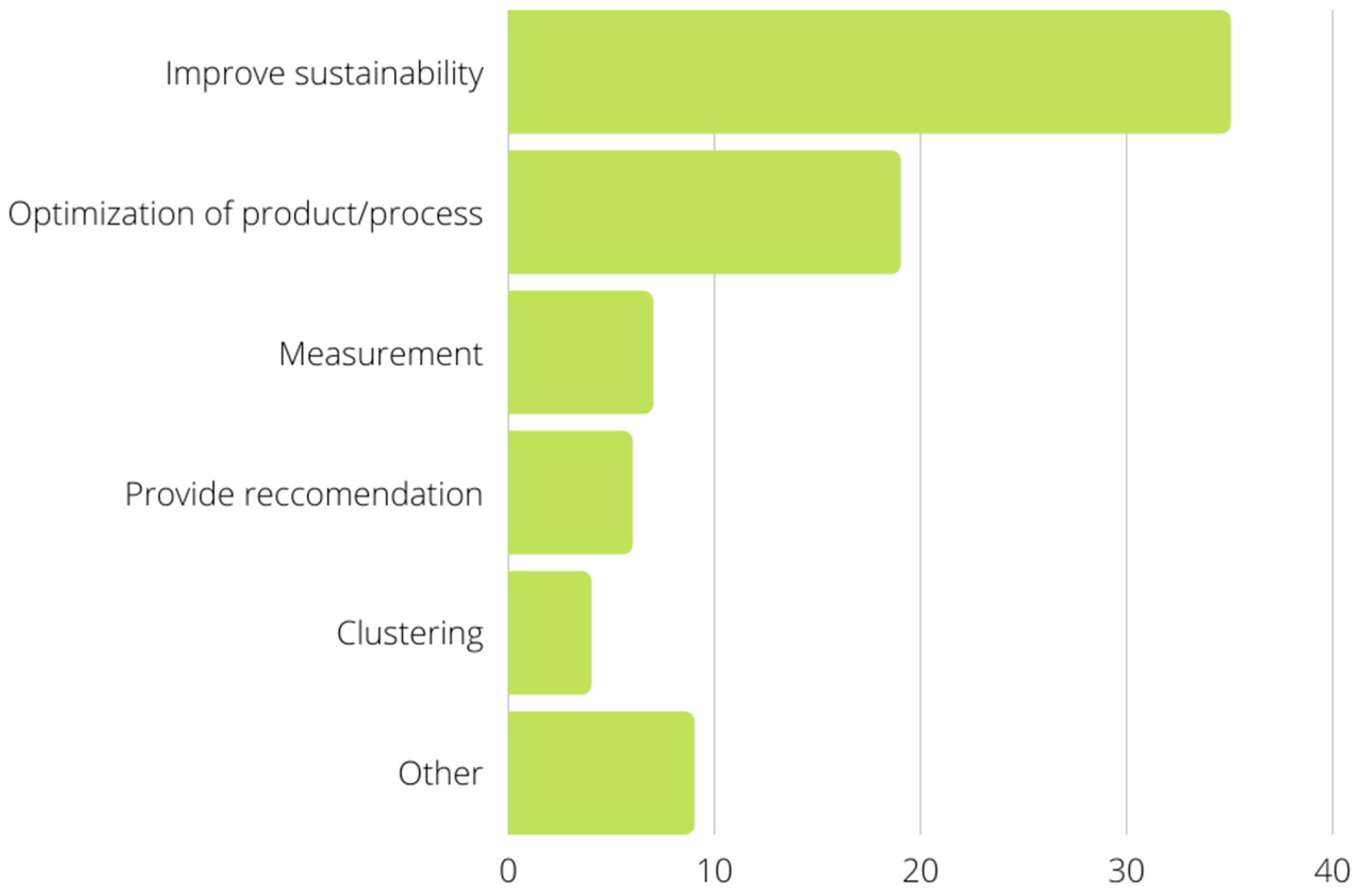
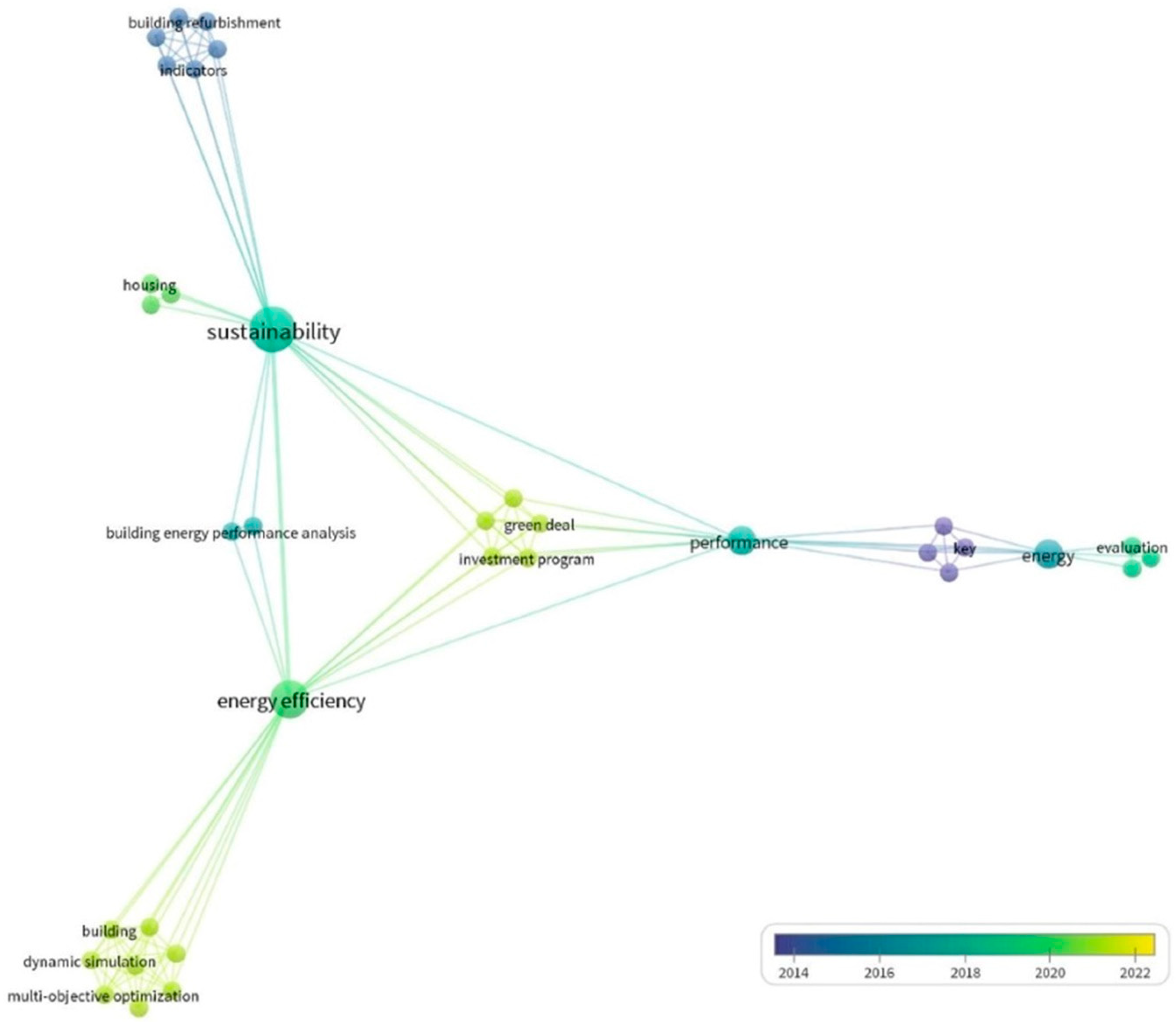
| Methodology | Papers |
|---|---|
| Simulations | [20,21,22,23,24,25,26,27,28,29,30,31,32,33,34,35,36,37,38,39,40,41,42,43,44,45,46,47,48,49,50,51,52,53,54,55,56,57,58,59,60] |
| Field measurement | [61,62,63,64,65,66,67,68] |
| Literature review | [69,70,71,72,73,74,75,76,77,78,79,80,81,82] |
| Other methodologies | [83,84,85,86,87,88] survey [89] coding [90,91,92] analysis [93] comparison |
| Scale | Papers |
|---|---|
| Urban | [21,26,29,44,54,58,64,70,72,78,90,91] |
| Building | [20,22,23,24,25,27,31,32,61,62,63,69,73,74,75,76,77,83,84,89] [35,37,41,42,43,45,46,47,50,51,52,53,67,68,79,80,85,86,87,93] [55,56,57,59,60,81,82,88,94,95] |
| Building materials | [33,38,48] |
| Building component | [30,34,36,40,65,66,71,92] |
| Component of building component | [28,39,49] |
| Main Aim | Papers |
|---|---|
| Clustering | [32,42,65,78] |
| Improve/measure sustainability | [22,24,25,26,34,35,36,38,40,41,43,45,46,51,52,53,56,57,58,59,61,62,66,70,71,74,75,80,83,87,89,90,91,92,93] |
| Optimization | [19,21,24,33,38,39,43,46,47,49,54,57,65,66,71,73,87] |
| Provide recommendation | [20,34,68,76] |
| Measurement | [64,84,91,92,93,94] |
| Other | [32] (investigate the perception of the importance of KPIs) [35] (validate hypothesis) [36] (pre-design evaluation) [73] (explore role of KPIs in DM) [37] (manage complexity) [48] (define material peculiarities) [85] (management) [54] (define relationships) [95] (evaluate success) |
| Author(s) | Main Focus | KPI 1 | KPI 2 | KPI 3 | KPI 4 | KPI 5 | KPI 6 | KPI 7 | KPI 8 |
|---|---|---|---|---|---|---|---|---|---|
| [22] | Building restoration | 6 | 1 | 1 | 3 | - | - | - | - |
| [61] | Reduce building energy demand | - | 2 | - | - | - | - | - | - |
| [24] | Reduce building energy demand | - | 4 | - | 1 | - | - | - | - |
| [25] | Reduce building energy demand | 1 | 1 | 1 | - | - | - | - | - |
| [26] | Reduce building energy demand | 1 | 2 | 1 | - | - | - | - | - |
| [70] | Promote sustainable water use | - | - | - | - | - | - | - | - |
| [71] | Remanufacturing | - | - | - | - | - | - | - | - |
| [89] | Building restoration | 5 | 2 | 1 | 2 | - | - | - | - |
| [83] | Building restoration | 5 | 2 | 1 | 2 | 1 | 1 | 1 | - |
| [90] | Urban and mobility sustainability | - | 1 | 2 | 3 | 2 | - | - | 17 |
| [74] | Circular economy | - | 1 | 1 | - | - | 2 | - | 2 |
| [62] | Sustainable maintenance and refurbishment | 4 | 1 | 4 | 2 | - | 8 | 5 | 9 |
| [75] | Sustainable construction | 1 | 1 | 4 | 2 | 2 | 1 | - | - |
| [34] | Optimize PV panels performance | - | 3 | 1 | - | - | - | - | - |
| [35] | Measure sustainability | 4 | 2 | - | - | 1 | - | 1 | 3 |
| [36] | Urban energy balance | 2 | 1 | - | - | 8 | - | - | - |
| [38] | Accelerate the transition toward a sustainable future | - | 2 | - | - | 2 | - | - | - |
| [40] | Reduce energy use | - | 7 | - | - | - | - | - | - |
| [41] | Energy saving | 3 | 16 | 5 | 1 | 8 | - | - | 1 |
| [43] | Improve building’s performance in terms of energy use | 5 | - | - | - | 2 | 2 | 3 | 3 |
| [66] | Reduce energy consumption | - | 4 | 1 | - | 1 | - | - | 2 |
| [91] | Circular approach in urban design | 1 | 2 | - | - | 3 | 2 | - | 3 |
| [45] | Limit energy use and losses | - | - | - | - | - | - | 4 | - |
| [93] | Define common features of IB (intelligent buildings) | - | 2 | 6 | 6 | 1 | - | 4 | 2 |
| [46] | Sustainability in BIM | - | - | 4 | - | - | - | - | 10 |
| [49] | Improve performances of plants | - | - | - | - | - | - | - | - |
| [80] | Building refurbishment | - | 1 | - | 1 | 1 | - | - | - |
| [51] | Multiscale analysis of the building | - | 1 | - | - | 1 | - | 10 | - |
| [52] | Improve eco-efficiency | - | 4 | 2 | - | 1 | - | - | - |
| [92] | Optimize processes and reduce waste | - | 1 | - | - | 1 | - | - | 3 |
| [87] | Optimize NZEB design | 2 | 1 | - | - | - | - | - | - |
| [53] | Sustainable energy use | - | 1 | - | - | - | - | - | - |
| [56] | Improve building performance | 6 | - | 1 | 1 | - | 1 | - | 1 |
| [57] | Improve energy efficiency | - | 1 | - | - | - | - | - | - |
| [58] | Improve urban and building performance | - | - | - | - | - | - | - | - |
| [59] | Improve building performance | 1 | 1 | 2 | 1 | 4 | 3 | 1 | 3 |
| Total amount of KPIs for each section | 47 | 69 | 38 | 24 | 39 | 20 | 29 | 59 | |
| Indicator | Frequency |
|---|---|
| Thermal comfort | 10 times |
| Energy consumption | 10 times |
| CO2/GHG emission | 6 times |
| Indoor air quality | 5 times |
| Renewable energy sources | 4 times |
| Daylight factor | 4 times |
| Discomfort hours (27–28 °C) | 3 times |
| Daylight requirement | 3 times |
| Investment costs | 3 times |
| Degree of satisfaction | 3 times |
| Wellbeing | 3 times |
| Solid waste | 2 times |
| Solar radiation | 2 times |
| Accessibility | 2 times |
| Initial costs | 2 times |
| Degree of privacy | 2 times |
| Eco-efficiency | 2 times |
| KPI 1.1—Indoor Thermal Indoor | |||||
|---|---|---|---|---|---|
| Author(s) | Methodology | Scale | Indicator | Tool(s) | Notes |
| [22] | Simulations | Building | Discomfort hours above 27 and 28 (°C) | - | - |
| [26] | Simulations | Building | LPD | HAMBase framework | - |
| [36] | Simulations | Building | Physiological equivalent temperature (PET) (°C) | Envi-met | - |
| [41] | Simulations | Building | - | - | Thermal comfort is considered as a secondary indicator |
| [43] | Simulations | Building | Temperature (°C) according to ASHRAE standards | BRESAER (EU Horizon 2020 project) BEMS | The tool is the result of the project |
| [56] | Simulations | Building | - | - | Simulations are not described in the paper |
| [62] | Field measurement | Building | Temperature (°C) | - | - |
| [83] | - | Building | PMV, PPD, Discomfort hours above 27 and 28 (°C) | Not defined | - |
| [89] | Simulations | Building | PMV, PPD | PARADIS | - |
| [91] | - | Building | PMV | Not defined | - |
Publisher’s Note: MDPI stays neutral with regard to jurisdictional claims in published maps and institutional affiliations. |
© 2022 by the authors. Licensee MDPI, Basel, Switzerland. This article is an open access article distributed under the terms and conditions of the Creative Commons Attribution (CC BY) license (https://creativecommons.org/licenses/by/4.0/).
Share and Cite
Mosca, F.; Perini, K. Reviewing the Role of Key Performance Indicators in Architectural and Urban Design Practices. Sustainability 2022, 14, 14464. https://doi.org/10.3390/su142114464
Mosca F, Perini K. Reviewing the Role of Key Performance Indicators in Architectural and Urban Design Practices. Sustainability. 2022; 14(21):14464. https://doi.org/10.3390/su142114464
Chicago/Turabian StyleMosca, Francesca, and Katia Perini. 2022. "Reviewing the Role of Key Performance Indicators in Architectural and Urban Design Practices" Sustainability 14, no. 21: 14464. https://doi.org/10.3390/su142114464
APA StyleMosca, F., & Perini, K. (2022). Reviewing the Role of Key Performance Indicators in Architectural and Urban Design Practices. Sustainability, 14(21), 14464. https://doi.org/10.3390/su142114464







